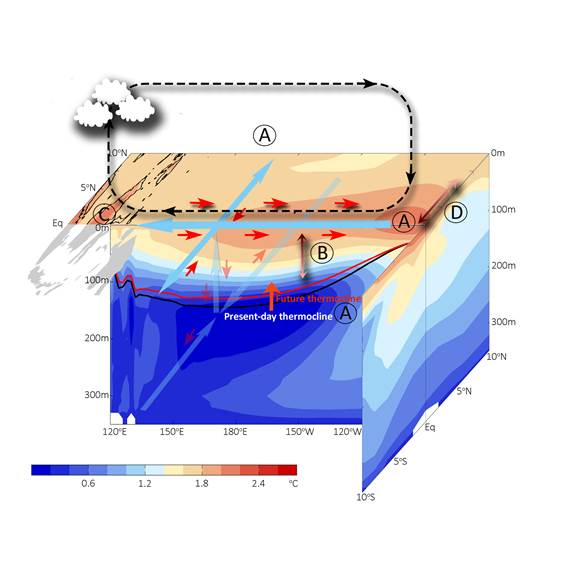ENSO and greenhouse warming

The El Niño-Southern Oscillation (ENSO) is the dominant climate phenomenon affecting extreme weather conditions worldwide. Its response to greenhouse warming has challenged scientists for decades, despite model agreement on projected mean state changes. Recent studies have provided new insights into the elusive links between ENSO and Pacific climate mean-state changes. The projected Walker circulation slow-down is expected to weaken equatorial Pacific Ocean currents, boosting the occurrences of eastward propagating warm surface anomalies that often characterise observed extreme El Niño events. Accelerated equatorial Pacific warming, particularly in the east, is expected to induce eastern equatorial Pacific extreme rainfall and extreme equatorward swings of the convergence zones, both of which are features of extreme El Niño. The frequency of extreme La Niña is also expected to increase in response to more extreme El Niños (an extreme La Niña tends to follow an extreme El Niños), an accelerated Maritime continent warming relative to the central equatorial Pacific promoting easterly during La Niña, and surface-intensified ocean warming.
The weakening Walker circulation is conducive to extreme positive Indian Ocean Dipole events, which typically lead to flood in east African countries but drought in Indonesia. This is because strengthening equatorial easterlies in boreal autumn associated with the weakening Walker circulation push warm water to the west and lift the thermocline in the east Indian Ocean contributing to the slower warming in the east than in the west. This facilitates more frequent occurrences of atmosphere convection movement from the east to the west Indian Ocean even if variability of the zonal sea surface temperature gradient does not change.
ENSO-related catastrophic weather events are thus likely to occur more frequently with unabated greenhouse gas emissions. For example, frequency of the rare occurrence of an extreme positive Indian Ocean Dipole accompanied by an extreme El Niño and followed by an extreme La Niña, as occurred during 1997-1999, increases dramatically. However, model biases and recent observed strengthening of the Walker circulation highlight the need for further testing as new models, observations and insights become available.

Box Figure | Schematic showing greenhouse-induced future changes at the surface (shown only for the north Pacific) and upper ocean along-equator and meridional cross-sections.Greenhouse-induced changes (red arrows) to the mean Walker circulation (dashed black with shadow) and mean ocean currents (cyan arrows) are indicated. Major features of changes are indicated by letters A, B, C, and D.
A Features associated with a weakening Walker circulation. The Trade winds and equatorial currents weaken, the eastern equatorial Pacific warms faster that the surrounding regions, and the thermocline shallows (present-day: black curve; future: red curve). The weakening equatorial zonal currents are conducive to an increased frequency of eastward propagating El Niño events. The faster warming in the eastern equatorial Pacific is favourable for an increased frequency of extreme El Niño events by promoting atmospheric convection. The increased occurrences of extreme El Niño are in turn conducive to an increased frequency of La Niña due to a discharged thermocline that promotes an influence of the subsurface cool water in the central Pacific.
B Increasing vertical temperature gradients, and C enhanced warming over the maritime continent. These changes are additional factors that facilitate an increased frequency of extreme La Niña events, through nonlinear zonal advection and Ekman pumping.
D Accelerated warming in the equatorial rather than in the off-equtorial Pacific. This change leads to an increased frequency of equatorward shifts of the ITCZ, which characterizes an extreme El Niño, and to an increased frequency of extreme swings of the SPCZ toward the equator. This occurs because atmospheric convection tends to follow maximum sea surface temperatures.
Summary written by Wenju Cai.
ENSO and greenhouse warming (Nature Climate Change)
Wenju Cai1,2*, Agus Santoso3, Guojian Wang1, Sang-Wook Yeh4, Soon-Il An5, Kim M. Cobb6, Mat Collins7,Eric Guilyardi8,9, Fei-Fei Jin10, Jong-Seong Kug11, Matthieu Lengaigne8, Michael J. McPhaden12, Ken Takahashi13, Axel Timmermann14, Gabriel Vecchi15, Masahiro Watanabe16 and Lixin Wu2
1 CSIRO Oceans and Atmosphere Flagship, Aspendale, Victoria 3195, Australia.
2 Physical Oceanography Laboratory, Qingdao Collaborative Innovation Center of Marine Science and Technology, Ocean University of China, Qingdao 266003, China.
3 Australian Research Council (ARC) Centre of Excellence for Climate System Science and Climate Change Research Centre, Level 4 Mathews Building, The University of New South Wales, Sydney 2052, Australia.
4 Department of Environmental Marine Science, Hanyang University, Ansan 426-791, South Korea.
5 Department of Atmospheric Sciences, Yonsei University, Seoul 120-749, South Korea.
6 School of Earth & Atmospheric Sciences, Georgia Institute of Technology, 311 Ferst Drive, Atlanta 30332-0340, USA.
7 College of Engineering Mathematics and Physical Sciences, Harrison Building, Streatham Campus, University of Exeter, Exeter EX1 3PB, UK.
8 Laboratoire d’Océanographie et du Climat: Expérimentation et Approches Numériques (LOCEAN), IRD/UPMC/CNRS/MNHN, Paris Cedex 05, France.
9 NCAS-Climate, University of Reading, Reading RG6 6BB, UK.
10 Department of Meteorology, SOEST, University of Hawaii, Honolulu, Hawaii 96822, USA.
11 School of Environmental Science & Engineering, Pohang University of Science and technology, Pohang 790-784, South Korea.
12 NOAA/Pacific Marine Environmental Laboratory, Seattle, Washington 98115, USA. 13Instituto Geofísico del Perú, Lima 169, Perú.
14 IPRC, Department of Oceanography, SOEST, University of Hawaii, Honolulu, Hawaii 96822, USA.
15 Geophysical Fluid Dynamics Laboratory/NOAA, Princeton, New Jersey 08540-6649, USA.
16 Atmosphere and Ocean Research Institute, University of Tokyo, Kashiwa 277-8564, Japan.
(Published online on













